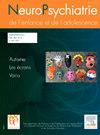身体的节奏划分和象征性的管弦乐。从对双胞胎婴儿的情感观察开始
Q4 Medicine
Neuropsychiatrie de l''Enfance et de l''Adolescence
Pub Date : 2025-09-01
DOI:10.1016/j.neurenf.2025.03.004
引用次数: 0
摘要
这篇文章的目的是把某些理论见解(不深入)和临床观察的共同线索是生命开始的运动,在它的价值的身体运动,情感运动和运动心理学。事实上,在我们的围产期儿童精神科的框架内,对脆弱环境中的婴儿的早期观察揭示了“变化”的早期障碍。表现/表达是非常不同的,只有躯体-精神的紊乱是共同的,并且以它们的强度和极端的对比为特征,通过混乱的时间性,不仅是生理和精神状态,还有婴儿的警惕状态和早期的互动。从这些婴儿痛苦的体征/症状开始,儿科医生、精神病学家和精神分析学家的公认经验指导我们在神经生理和心身方面进行动态临床思维。我们的研究面向生命最初阶段的运动、节奏和感官。对双胞胎婴儿的临床观察提高了我们对这些生理方面的认识,并证明了新生儿环境在适应/调整/调谐方面的价值。对于新生儿科医生来说,一个渐进的躯体/身体/精神组织是在生命的最初几周,根据身心医生的说法,婴儿生命的前九个月,甚至是心理围产期医生的前1000天。经验和生活经验为思想提供了材料,反之亦然,在这些早期阶段,走向一种过渡性(肉体和心理)的存在方式和存在方式。情绪是第一个身体-精神信封的基本本质,它最初采取共同主办的节奏运动的形式,它是一个重要的动力来源和一个微妙的身体-精神平衡的创造者,朝着复杂的发展/成长动态。在这些交叉反思的过程中,建立了古代的当代临床思想,同时建立了肉体,发展,心理动力学和精神分析。本文章由计算机程序翻译,如有差异,请以英文原文为准。
Partition rythmique et orchestration symbolique du corps. En partant de l’observation émotionnelle de bébés jumeaux
The purpose of this article is to put into perspective certain theoretical insights (without going into depth) and clinical observations with the common thread being the movement of the beginnings of life, in its valency of physical movements, emotional movements as well as movement psychics. Indeed, within the framework of our perinatal child psychiatry unit, the early observation of babies in vulnerable environments revealed “changing” early disorders. The manifestations/expressions were very disparate, having only somato-psychic disorganization in common, and were marked by their intensity and extreme contrasts, by a chaotic temporality, not only physiological and tonic states, but also states of vigilance of babies and again early interactions. Starting from the repertoire of these signs/symptoms of babies’ suffering, the recognized experience of pediatricians, psychiatrists and psychoanalysts directed us towards dynamic clinical thinking in its neurophysiological and psychosomatic dimensions. Our research was oriented towards the movements, rhythms, and sensorialities of the first stages of life. Clinical observations of twin babies raised our awareness of these physical aspects of their conditions and testified to the value of the neonatal environment in terms of adaptation/adjustment/attunement. A progressive somato/corporal/psychic organization is discussed during the first weeks of life for neonatologists, the first nine months of the baby's life according to psychosomaticians, or even the first 1000 days for psy-perinatalists. Experiences and lived experiences provide material for thought and vice versa, towards a state of transitionality (corporeal and psychological) of ways of being and existing in these early ages. Emotionality reveals itself as a fundamental essence to the first corporo-psychic envelopes, its originally takes the form of a co-hosted rhythmic movement, it is a source of vital momentum and generator of a delicate somato-psychic balance towards a complex development/growth dynamic. Over the course of these cross-reflections, a contemporary clinical thought of the archaic was established, at the same time corporeal, developmental, psychodynamic and psychoanalytic.
求助全文
通过发布文献求助,成功后即可免费获取论文全文。
去求助
来源期刊

Neuropsychiatrie de l''Enfance et de l''Adolescence
Medicine-Pediatrics, Perinatology and Child Health
CiteScore
0.60
自引率
0.00%
发文量
61
期刊介绍:
Organ of the Société française de psychiatrie de enfant et de adolescent, Neuropsychiatrie de enfance et de adolescence tackles all fields of child-adolescent psychiatry and offers a link between field and clinical work. As a reference and training tool for students and practitioners, the journal publishes original papers in child psychiatry as well as book reviews and conference reports. Each issue also offers a calendar of the main events dealing with the speciality.
 求助内容:
求助内容: 应助结果提醒方式:
应助结果提醒方式:


